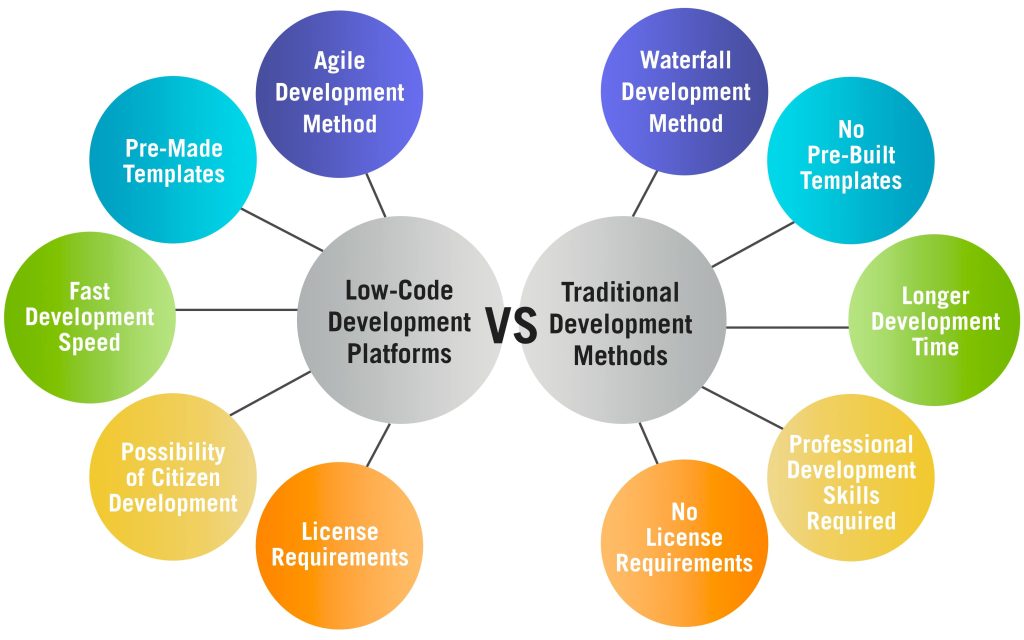
Software development has made great strides in the last few decades. It’s long been the exclusive purview of computer enthusiasts and remained out of reach for ordinary people. But nowadays, the need to learn coding languages and the way computers operate (which, let’s face it, can often be counter-intuitive) is no longer a barrier to software development.
Table of Contents
- What is traditional software development?
- What are traditional software development models?
- Traditional software examples
- Benefits of traditional software development
- Drawbacks of traditional software development
- What is low-code development?
- Examples of low-code platforms
- What kinds of applications can be built with low-code platforms?
- Drawbacks of low-code
- Benefits of low-code
- Factors to consider when changing applications
Lean development environments now enable amateurs and professionals alike to get to work creating applications in a fraction of the time traditional methods would require.
These environments, usually offered as services that you can sign up for, are set up in such a way that you never need to start from scratch. You can just gather various functions, libraries and other prefabricated components into an environment where the difficulties have been largely cleared out, and where you’re ultimately only able to produce functional results.
This is called low-code development, since the amount of code required from the programmer is very limited. It offers some benefits over traditional software development.
But let’s start from the beginning…
What is traditional software development?

Traditional software development is a large-scale operation.
In this field without concrete paths or destinations, one needs to follow a rigorous approach to avoid getting lost along the way. Recall that software is basically a series of instructions written in a foreign language, running inside a machine whose operation is invisible to the naked eye.
Even the final result is only partially discernible to users or the programmer, and most times, when you declare a software development project complete, you’re taking a leap of faith—after all, bugs can manifest in incredibly varied ways.
Unlike building a house or assembling a car, for example, it’s difficult or impossible for developers to picture exactly what their final product will look like. There are no concrete indicators to intuitively understand the progress of the project, or to anticipate obstacles and how to overcome them.
These obstacles can be physical, in the simplest cases, or software-based, in the more complex cases. Assessing the capabilities of any given hardware is relatively easy, but the limitations of a computer language or its interoperability with all equipment are not always clear until they’ve been tested, and that’s when you’re venturing into uncharted territory.
This is why traditional software development methods are primarily focused on a rigid and rigorously detailed structure.
To ensure that no detail is forgotten and that every step forward is built on a solid foundation, it’s crucial to meticulously plan, document and mark out the steps to be taken. Equally crucial is ensuring that all developers know exactly what’s expected of them at all times. In order to achieve these numerous and ambitious objectives, elaborate working methods needed to be created.
What are traditional software development models?

There are several models for traditional software development: the waterfall model, the iterative (spiral) model and the V-model are some of them.
Waterfall Method
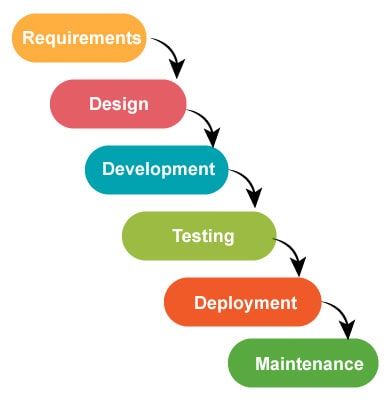
Created by the US Navy in the 1960s, the waterfall model, where production steps simply follow one another, is the oldest and most widely used. Its linearity and simplicity make it the easiest model to understand.
The number of steps involved may vary, but the waterfall model primarily starts with a rigorous definition of requirements. Those requirements then serve as the foundation for the rest of the steps: architecture, detailed design, development (code), testing phase, deployment and maintenance.
It’s a rigid model that only works when adhered to very closely, and it must be based on clearly defined requirements, making it difficult to course-correct along the way.
Iterative Method
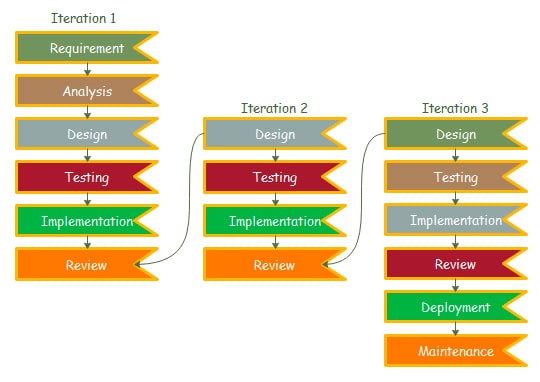
Also called the spiral model, it’s designed to address the rigidity of the waterfall model.
This model assumes that development isn’t just a series of steps in a straight line, but rather a succession of iterations of those steps. Developers therefore go through the same steps several times until the objectives are reached.
The main benefit of this model is the way plans can be revised if development hits any sort of snag along the way. And since going back over previous steps is baked into the model itself, there’s no need for perfection on the first try. This saves time and provides a lot of flexibility, since you can know early on whether you’re on the right track and can add features without needing to reimagine the concept.
V-model
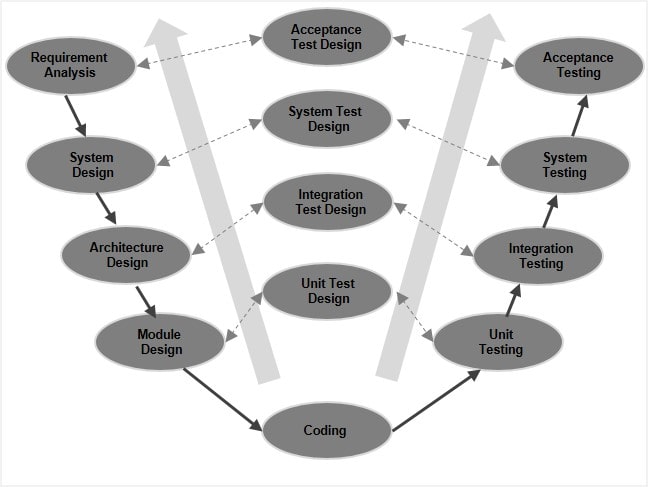
Finally, there’s the V-shaped development model. It is based on the waterfall model but makes it possible to tackle more complex projects by adding more elaborate test steps and recursion into the development process.
The V shape comes from the “branch” formed by test steps that start at the end of development and go back up the cycle to the first steps, optimizing all of them along the way.
These three models, while tried and true, can be improved upon.
Traditional Software Examples

Traditional methods can be suitable for highly structured software.
Examples can include human resources management software, content management software and internal banking software. What these types of software markets have in common is that they prioritize stability and security over cost or speed of execution.
Traditional methods can work in these situations, since the development process will necessarily be built on detailed requirements, and each step cannot be completed without all criteria being exactingly met.
Here, ongoing communication between the client and the developer, or the addition of requirements during the course of the project, is not welcome, as it may pose security and stability risks.
Benefits of Traditional Software Methods

Methods don’t become “traditional” by never working. The ones that earn this title obviously display certain benefits.
Traditional methods have the distinction of being long established. Note that, although it has grown very popular in recent years, the “agile” method will not be considered traditional for the purposes of this article.
Low-code, on the other hand, is a very recent invention that was only made possible after several decades of traditional development. After all, the precoded components of the low-code originate from traditional software development.
And so, traditional methods feature several benefits.
Freedom

First, and not least, is the fact that traditional methods let you create anything you want. Since you’re starting from scratch and have to build everything yourself, you are theoretically limited only by your ambition and your means.
In which language(s) will the software be created? For which operating system? What will be its scope? What capabilities will it feature? The answers to these questions can all be tailored to meet the client’s needs.
As long as their requirements are clear and accessible, the client can receive whatever product they want at the end of the development.
Ease

Secondly, the pre-established sequential structure of these methods makes it easy to track their progression and assess the required budget and time. Since the initial requirements and the objectives of each step are clearly established, both management and team members can easily direct their questions to the appropriate contacts and mobilize the proper resources to overcome obstacles.
Autonomy

The rigidity of traditional methods, which may seem like a downside, can also be a quality, since it offers the possibility of progress without regular input from the client. Developers can work on deliverables without fear of making mistakes or being paralyzed by uncertainty, since they rarely need to wait for client responses before moving forward.
Profitability
As clarity is a strength of traditional methods, they make it easy to calculate labour and equipment costs, and unforeseen events rarely occur.
Direction

Since traditional methods have a rigid sequential structure, the content of each step is known, and the objectives are clear throughout the development, it’s easy to quickly assess the time required and to accelerate production if necessary. The idea that rapid progress is much easier on familiar ground is a guiding principle of traditional methods.
And although these methods are generally slower than low-code projects, this is mainly because they’re generally used to tackle much more ambitious visions.
Drawbacks of Traditional Software Development Methods

Of course, traditional methods have their downsides too.
Complexity

Not all software development projects are of the same size, and lighter methods are sometimes preferable. Traditional methods involve developers coding software from the ground up, which requires relatively advanced programming knowledge.
You need to be familiar with programming languages, operating systems, production environments, servers, and other computer components to achieve sufficient proficiency.
Opportunities to make mistakes abound, and a beginner can’t simply jump into software development without the proper support.
Heaviness
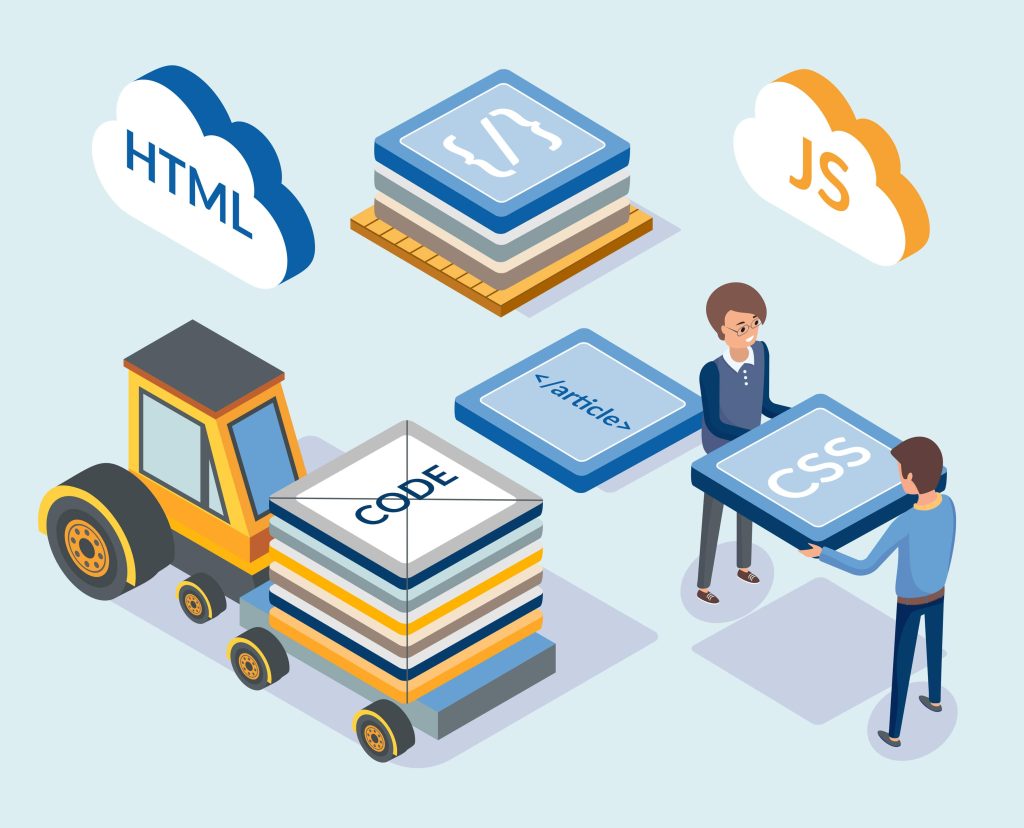
Software made in the 2020s needs to be hosted on the cloud, or at least to be fully functional on it. Ideally, development should be doable from anywhere, without the need to have access to specific computers or servers. Once the software is finished, it must also be accessible from anywhere.
Meeting these criteria using traditional methods isn’t always easy, since you need to create the environment in which development will take place, and transferring it during the process, if necessary, can be difficult.
Inflexibility

Once the client’s requirements and the steps needed to complete the software development process are established, traditional methods don’t leave much room for changing your mind.
Because they involve development from the ground up, the time investment can be significant even for a minor task, and it becomes costly to go back and make changes to the requirements.
In addition, software created under these conditions is usually tailor-made to work in specific environments—with a particular programming language, operating system, or hardware—and doesn’t lend itself well to unforeseen changes.
For the same reasons, features created during development are rarely reusable elsewhere, since they’re also specialized. So you need a client or user who’s willing to go through with the process once it starts.
Lastly, the fact that these methods offer limited opportunities for modifications means that you may end up with software that’s the result of the programmers’ understanding, but which doesn’t entirely match what the client had in mind.
What is low-code development?

As the name implies, low-code is a programming method in which the amount of code the developer needs to provide is kept to a minimum. This means that most of the code has been pre-written, and the programmer can simply choose from already established components, without having to program everything from scratch.
An analogy for this method would be the difference between ready-to-wear and custom-made clothing.
Or, if you want to stick closer to reality, picture an application in which users can drag-and-drop or copy-and-paste different folders and functions, write entire functions themselves, or just use those already offered in the interface.
It’s a visual-based approach designed to create ad hoc business tools and to give employees full control over the fields they’re experts in.
Examples of Low-Code Platforms
Several platforms are available to get you started in low-code programming. We will introduce some of them here, including Claris FileMaker, OutSystems, Appian and Microsoft PowerApps.
FileMaker

This “software as a service” published by Claris is a cross-platform relational database application. It has a graphical interface and security features that allow users to modify databases by dragging and dropping various elements into forms, screens, or presentations to create applications quickly and independently.
This software is now available online and can be used on any operating system. It’s a handy tool for companies that want to have the means to develop in-house software solutions tailored to their particular business needs.
Its strengths are ease of use, good technical support and high customizability.
OutSystems
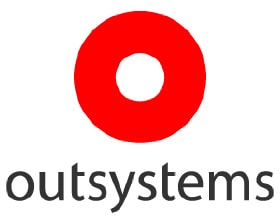
Founded in 2001 in Lisbon, OutSystems is a low-code development platform that found overnight success when it received several
hundred million dollars of funding from Goldman Sachs and KKR. It has reached “unicorn” status on the financial markets, and its total valuation is close to $9.5 billion.
OutSystems is proportionally popular with developers, too: according to PCMag, it may be the most powerful low-code development platform for programmers. It’s one of the oldest low-code platforms, as well as the one that’s best suited to this philosophy.
It provides a guided and customized programming experience, tailored to the role and skill level of the programmer. Its library of interactive training and support resources makes it a sensible choice, as does its well-stocked store of pre-coded components and integrations.
Appian

With its app of the same name, the Virginia-based company offers a paid low-code development platform for businesses that emphasizes the collaborative aspect of creation.
Like its competitors, Appian got started at the turn of the 21st century when it set out to help companies improve their business processes.
Targeting large companies, its platform integrates collaboration and task management functionalities as well as an intranet.
Its Quick Apps feature provides a literally no-code experience, as well as decision rules to simplify complex business logic.
Microsoft Power Apps

Power Apps is among the newer platforms of its kind. Thanks to the computing giant’s considerable resources, it rides the low-code wave with a product that’s more streamlined than its competitors, yet just as powerful.
Its relative newness gives it a less cluttered user interface, and its capabilities live up to expectations. It boasts a perfectly adequate range of features, user interfaces, templates and integrations while its functionality for mobile devices stands out.
Were it just slightly easier to use, it would have no problem competing with the category’s heavyweights.
What kind of applications can be built with low-code platforms?

While not yet up to the task of building critical applications, low-code development can produce, among other things, great solutions for managing customer service, enhancing organizational efficiency and modernizing obsolete programs.
For a concrete example, picture an application made for serving a university’s student body, or one to process orders for a mail-order company. You can also imagine an application that processes invoices or registrations for an organization, or even claims for an insurance company.
Low-code also allows you to modernize obsolete applications, such as migrating Lotus Notes or Microsoft Access to the cloud, or adding functionality to your accounting systems.
The possibilities of low-code are too many to name, and it has proven to be a crucial tool in the field of development platforms. What’s more, thanks to ongoing advances in artificial intelligence, these possibilities are growing by the day.
Artificial intelligence uses language processing to interpret and anticipate the needs of programmers. We’re likely to see this approach become a standard, which will definitely disrupt the software development world.
What are the drawbacks of using low-code platforms?

It’s only natural that conducting development in an environment that’s already been defined and marked out by someone else will limit the possibilities open to you. You may have to come to terms with the fact that your dream feature set can’t be integrated.
In addition, intellectual property issues can make things difficult. Remember—the pre-coded components you’ll be using, and the servers on which your application will be hosted, are legally the property of the platform owner. If the owner decides to make changes to their platform, you might lose access to these components.
What are the benefits of using low-code platforms?

The benefits are numerous: low cost, ease of use, no maintenance required, greatly reduced production time (a few weeks instead of a few months).
In the world of software development, low-code has an obvious appeal: people with little or no programming experience can develop basic applications on their own. This can represent huge potential savings for a business.
For example, low-code allows the person most familiar with an issue—the in-house expert, if you will—to be the one to develop the software solution. Just the time and money that would be required to delegate the programming to a third party already makes using low-code development worthwhile.
Don’t underestimate ease of use. Imagine if your neophyte programmers had to write the code behind every colour on the screen and every button in the app, in addition to writing the complex functions that make your systems work.
Low-code is a visual-based approach—all the basic functions are already established, and the programmer can concentrate on the essentials. The basic techniques already ubiquitous on computers, such as drag and drop or copy and paste, allow beginners to progress quickly.
Factors to consider when switching platforms

Making the full switch from traditional development to low-code development is no easy task. In fact, it’s probably a better idea to consider these two approaches as complementary rather than competing; low-code solutions can be layered onto traditional software to enhance functionality, improve security and extend capabilities.
While businesses can certainly benefit from the freedom to innovate that low-code development brings, large-scale migration should be undertaken with a team of experienced developers, and not solely citizen developers, in order to optimize underlying application structure, security and backups, and data integrity. Even should the progress of artificial intelligence enable huge applications to be developed in the future, human supervision of the whole process will likely always be necessary.
Sources:
https://www.cs.uct.ac.za/mit_notes/human_computer_interaction/htmls/ch03s04.html
https://www.kpipartners.com/blog/traditional-vs-agile-software-development-methodologies
https://www.objectivity.co.uk/blog/low-code-traditional-development/#An_Overview
https://www.geeksforgeeks.org/software-engineering-spiral-model/
https://www.geeksforgeeks.org/difference-between-traditional-and-agile-software-development/
https://www.ionos.fr/startupguide/productivite/modele-en-spirale/
https://fr.wikipedia.org/wiki/Cycle_en_V
https://www.pcmag.com/reviews/outsystems
https://www.techradar.com/reviews/claris-filemaker-pro-19-review
https://www.pcmag.com/reviews/microsoft-powerapps
